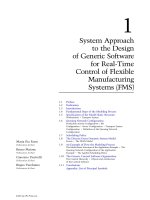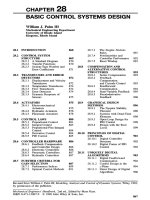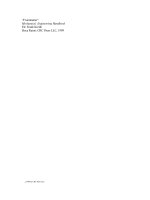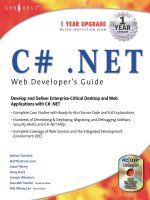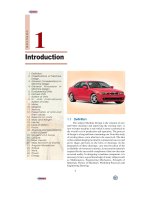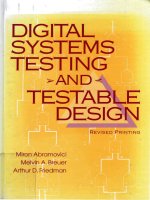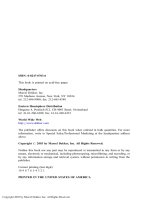Mechanical Actuator Design Guide P1 doc
Bạn đang xem bản rút gọn của tài liệu. Xem và tải ngay bản đầy đủ của tài liệu tại đây (1.76 MB, 30 trang )
Power Jacks Limited
Maconochie Road Fraserburgh AB43 8TE
Tel: 01346 513131 Fax: 01346 516827
email:
Certificate No. FM23810
Mechanical Actuator Design Guide
Power Jacks Limited
Maconochie Road Fraserburgh AB43 8TE
Tel: 01346 513131 Fax: 01346 516827
email:
SCREW JACKS • ACTUATOR SYSTEMS • ELECTRO-MECHANICAL ACTUATORS
POWER TRANSMISSIONS
• ACTUATOR CONTROL SYSTEMS • MECHANICAL JACKS • ROTARY UNIONS
®
POWER JACKS
PJMADG-02
MECHANICAL ACTUATOR
DESIGN GUIDE
POWER JACKS
Distributed by:
1
Company Profi
l
e
• Mechanical Jacks
• Reduction Gear Boxes
• Bevel Gear Boxes
• Power Transmissions
• Actuator Accessories for Complete Actuator Systems
• Actuator Motion Control Systems.
These products can be provided as individual parts or single
or multiple actuator systems with full engineering consult-
ancy available as part of the service.
As well as these standard products Power Jacks has a
dedicated engineering team for the design of “Special”
actuators to suit all customer requirements.
There are over two million of our actuators successfully in
operation world-wide and our partners Duff-Norton are the
world-wide market leader in linear actuation systems. By
specifying a Power Jacks product you are assured of quality,
reliability, performance and value. In the United Kingdom
there is a team of highly experienced sales engineers to
assist customers with their actuation applications whether
on site or by direct communications with the Fraserburgh
factory. For overseas customers there is an extensive
distributor network world-wide.
Power Jacks Limited
Maconochie Road
Fraserburgh
Aberdeenshire
AB43 8TE
Tel: 01346 513131 Fax: 01346 516827
Email:
Internet:
Interactive CD-ROM with 2 Design
Guides, 4 Product Guides and CAD
drawings.
Power Jacks Internet site for product
information and news with down-
loadable Catalogues and CAD drawings.
P
ower Jacks is the largest and most experienced
manufacturer of actuators and mechanical jacks
in the UK. With our range of Duff-Norton actuators
you don’t just get the product, you also get the
knowledge and experience from a company that has,
since 1883, manufactured quality industrial lifting,
positioning and materials handling equipment.
On our extensive site in Fraserburgh, Aberdeenshire,
we have a wide range of engineering facilities
including CAD/CAM/CAE technology to aid engineer-
ing design and manufacture, an advanced production
control system ensuring the optimum product flow
through our comprehensive range of conventional
and CNC machining facilities, which maximises
efficiency and reduces delivery times.
This is achieved with our 100+ highly trained
employees, giving Power Jacks the capability to
produce mechanical engineering of the highest
standards.
Quality is a key part of Power Jacks' working philo-
sophy and built into the product from initial design
conception, through production, to installation and
after sales service.
Power Jacks standard actuation product range covers:-
• Machine Screw Worm Gear Actuators
• Ball Screw Actuators
• Stainless Steel Actuators
• Micro-Miniature Actuators
• Electro-Mechanical Actuators
COMPANY PROFILE
2
1. Ideas & Application Guide to
Mechanical Actuators
1.1. Mechanical Actuator Product Range Summary
1.2. Typical Applications
1.3. Flow Chart For System Building
1.4. Examples of Special Actuators
1.5. Selecting An Actuator
1.6. Actuator System Selection Guide
1.7. Worksheet / Application Analysis Form
1.8. Actuator Product Codes For Ordering
2. Machine Screw Actuators
2.1. Sym-metric Actuator Models
2.2. Metric Machine Screw Actuator Models
2.3. Imperial Machine Screw Actuators
2.4. Stainless Steel Metric and Imperial Actuators
2.5. Micro Miniature Actuator
3. Ball Screw Actuators
3.1. Metric Ball Screw Actuators
3.2. Imperial Ball Screw Actuators
3.3. High Duty Cycle Ball Screw Actuators
4. Power Transmissions
4.1. CMC Spiral Bevel Gear Boxes
4.2. BA-Series Cubic Spiral Bevel Gear Boxes
4.3. Reduction Gear Boxes
4.4. Flexible Couplings
4.5. Drive Shafts and Plummer Blocks
5. Motors
5.1. Motor Adaptors
5.2. Electric Motors
6. Examples of Linear Motion Controls
7. Motion Control Systems
7.1. Motion Control
7.1.1. PowerMAX Frequency Converter
7.1.2. Rotary Limit Switches
7.2. Position Indicators
7.2.1. Analogue Position Indicator
7.2.2. Digital Position Indicator
7.3. Actuator System Control Panels
8. Engineering Guide
The engineering guide section contains detailed
information relating to all mechanical actuators to aid
application analysis e.g. critical speed and column strength
charts.
8.1. Actuator Performance
8.2. Actuator Product Operation Features
8.3. Installation And Maintenance Tips
8.4. Engineers Reference
(Engineering Guide has its own contents page)
Design Guide Contents
MECHANICAL ACTUATOR
DESIGN GUIDE CONTENTS
3
P
ower Jacks design and manufacture special actuators to suit specific
customer applications whether this requires modification or addition to a
standard product or the design of a completely new actuator.
Conventional
Machine
Screw
Actuators
Ball Screw
Actuators
Sym-metric
Machine
Screw
Actuators
Miniature
Actuators
Special
Actuators
Actuator
Accessories
C
ubic style metric actuator designed and manufactured in the UK. This
actuator was designed with a higher thermal efficiency than conventional
machine screw actuators, allowing higher duties and working temperatures, and
improved mounting arrangements e.g. Upright and inverted positions are now
incorporated in one model.
T
he ball screw actuator can run at higher duties and speeds than machine
screw actuators through the high efficiency of the ball screw and nut. The
ball screw also provides longer life at load and requires less power than a
machine screw actuator for a specified thrust. The range is available with the
same number of metric and imperial variants as the machine screw range. All
metric models have a ball nut safety device as standard. A high duty cycle
model for continuous operation is also available.
P
robably the most widely used mechanical actuator for
intermittent duty cycles as the actuator incorporates a
precision worm gear set in a rugged casting delivering
positive, precise actuation. Available in a comprehensive
range including metric models, imperial models in
standard materials or stainless steel models for special
environments.
D
esigned for applications which call for extremely
precise very small adjustments. To achieve their high
accuracy they are equipped with anti-backlash nuts as
standard to minimise vertical backlash between the lifting
screw and worm gear nut. These actuators are available with a
corrosion resistant finish or in stainless steel for harsh
environments.
P
ower Jacks have a comprehensive range of actuator
accessories including power transmissions and motion
control systems. A turn key actuation solution can
therefore be provided to the customer whether it be for
singular or multiple actuator systems.
1.1 Product Range Summary
1.1. MECHANICAL ACTUATOR
PRODUCT RANGE SUMMARY
4
Typical Applications
1.2. TYPICAL APPLICATIONS
Aircraft Access
Equipment
Section Rolling
Machine
Heavy Duty Straightening Machine
Printing Press
T
here are over two million Duff-Norton
actuators operating successfully in a
wide variety of industries including paper,
food processing, nuclear, steel, transport,
aerospace, communications and leisure.
Medical Examination Table
Double Pinch Bending
Rolls Machine
Access Platform Lift for
Aircraft Wing ManufactureActuators with Shock Absorbers
Strip Guide Adjusters
5
Plate Leveller
Satellite Dish Positioning
12 Head Horizontal Band Saw
T
he applications are wide, varied
and ever increasing as pneumatic
and hydraulic technologies are replaced
by what can be a cleaner, quieter and
more reliable solution.
Typical Applications
1.2. TYPICAL APPLICATIONS
Quick Hitch for Excavator
Bucket Attachment
Particle Accelerator
Steel Strip Tension Leveler
Roll Tensioner
Adjuster to Paper Machine
Stadium Access Lift
6
Power Jacks
Actuators Can:
Position Precisely
Move to a Position and Hold
Be Programmed to give
Variations in
Cycles and Positioning
Apply a Force
Horizontal Actuation
Machine Operator
Clamping
Electric Control Relays
Platform Lifts
Programmable Logic
Controllers (PLC's)
Coupled together
for Multiple
Actuator System
Opening and Closing
Activated by
Mechanical Switches
Proximity Sensors
Counters
Temperature
Density
Pressure
Load
Photo Electrics
Colour Sensor
Calibration
Torque
Push and Pull at Rated Load
For Controlled by
Individually Motorised
Tilt/Angle Adjustment
1.3. FLOW CHART
FOR SYSTEM BUILDING
1.3. System Building
7
To Build the Complete Actuation System for any Application
Electric Motor
(Face Flange or
Foot Mounted)
Limit Switch Coupling Bevel Gear Box
Air Motor/
Hydraulic Motor
Proximity Sensor Torque Limiter Reduction Gear Box
Hand Crank Optical Encoder Clutch Geared Motor
Brake Motor Four Output Encoder V-Belt Drive Motor Drive
(Motion Controller)
Electric Brake Linear Variable Differential
Transducer (LVDT)
Plummer Blocks HMI
(Human Machine Interface)
USING THESE SYSTEM DEVICES
System Devices
8
Powered by hand crank or motor, actuators raise,
lower, open, close, push, pull or adjust.
+or
Brake motor used for stopping and precise
positioning. Required for all ball screw actuators and
machine screw actuators with vibration or prolonged
holding periods.
+
Factory-mounted adjustable limit switches for top
and bottom stroke limits.
Optional limit switch with potentiometer and
transducer for positioning with analog read out.
Precision positioning control with digital encoder.
+
+
Stepping motors are used with PLC for precise
incremental indexing with adjustable
accelerate/decelerate modes.
DC servo motor plus drive for high accuracy, high
torque applications.
+
++
+
Linear variable differential transducer LVDT AC/DC -
for precision measurement of actuator screw
movement.
+
Pulse generator for Control System input and/or LED
readout.
+
Shaft-mounted magnetic disc with sensor for speed,
and position monitoring.
+
+
EXAMPLE ACTUATOR
SYSTEM BUILDING
System Building
9
DC Speed Control.
Stepping motors for independent positioning with
separate controllers for uniform positioning of both
actuators, where connecting shafting is not possible.
Protect a system from overload with motor current
limiter or clutch.
B5/B14 face/flange, mount motors mounting motor
directly to actuator, in capacities from 25 kN to
200 kN and 2 tons to 20 tons.
AC frequency inverter provides constant torque with
varying speed.
Actuators used in isolated environments, sometimes
connected by a drive shaft, shield and protect
against fumes, temperature, radiation, vacuum,
hostile environment.
Air motor for clamping with preset valve. Air motor
goes into stall to maintain force.
Sprocket V-belt drive, motor, pillow blocks.
Platform lifts with individually motorised actuators
synchronised with a motion controller with encoder
for speed and position feedback and motor drive unit
(all motor types).
Mechanically linked and driven four actuator system.
+ ++
+
+
+
+x 2
++
+
++
+
+ x 2 +4 x
+or
or
+
+++
x 4 +
+
+
EXAMPLE ACTUATOR
SYSTEM BUILDING
System Building
10
Power Jacks
can adapt the
standard actuator to
meet your special
requirements.
Special friction pad
Folding handle
Self-aligning ball bushing
Clevis
plug
in base
Hexworm shaft for hand
crank or socket
for portable drill
Inverted jack with boot
replacing
top pipe for
limited
space
Air motor restrainer
actuator pad bearing
surface
Ball socket keyed
lifting screw
Thrust washers instead of
ball bearing, for impact
loading
Keyed inverted
anti-backlash
Translating tube models
Key
adaptor
Special tap-in
screw
Spherical radius
keyed screw
Tapped
hole
Swivel
capability
Guide
bushing
Plunger
Flag
down
position
Screw end
Special
wiper
seal
Special clevis end 15° Swivel top plate
keyed screw
Lifting
Nut
1.4. EXAMPLES OF
SPECIAL ACTUATORS
1.4. Special Actuators
11
1.5. Selecting an Actuator
η
ad
=
Dynamic Actuator Efficiency
η
as
=
Static Actuator Efficiency
P
in
(kW)
=
Load (kN) *Raise Rate (mm/min)
60000 *
η
ad
T (Nm)
P (kW) *9550
N (rpm)
ino
i
=
in
T
ins
=
Load (kN)*Pitch (mm)*N
o
of Starts on Lifting Screw
2*
π
*
η
as
*GearRatio
N (rpm)
Raise Rate (mm / min) *Gear Ratio
Pitch (mm) * N of Starts on Lifting Screw
o
=
1.5. SELECTING
AN ACTUATOR
The following selection procedure is applicable for machine screw and ball screw actuators.
1.5.1. Five Step Guide to Initial Actuator Selection
Calculate Power & Torque Requirements
Select an actuator from the tables with adequate load carrying capacity and note the actuator static and dynamic efficiency for
the required input speed.
Step1 - Actuator Input Speed
Note:- Actuator Input Speed should not exceed 1800 rpm.
Step 2 - Operating Input power (kW), P
in
:-
Step 3 - Operating Input Torque
Step 4 -Actuator Start-Up Torque
Step 5 - Mechanical Power & Torque Check
Check whether the actuator power and torque required for the application is not greater than the maximum allowable mechanical
input power (P
mechanical
) and Start-Up Torque at Full Load (T
s
) values specified in the actuator performance tables.
If P
mechanical
> P
in
& T
s
> T
ins
then the actuator selected is acceptable for power requirements.
12
1.5. Selecting an Actuator
P (kW)
15 (kN) *100 (mm / min)
60000 *0.275
in
=
T (Nm)
0.091 (kW) * 9550
100 (rpm)
ino
=
P
in
= 0.091 kW
T
ino
= 8.7 Nm
T
15 (kN) *6 (mm) *1 (N of Starts on Lifting Screws)
2 * *0.208 *6 (Gear Ratio)
ins
o
=
π
T
ins
= 11.5 Nm
η
as
=
0.208 (refer 2.1.1.)
N (rpm)
100 (mm / min) *6 (Gear Ratio)
6 (mm) * 1 (N of Starts on Lifting Screw)
o
=
N = 100 rpm
1.5. SELECTING
AN ACTUATOR
Example Initial Actuator Selection
Application Contraints:-
• Load on Actuator = 15 kN in Tension
• Raise Rate required = 100 mm/min
Consider all application constraints then choose an actuator that looks suitable for the application with an actuator load rating equal
to or greater than the maximum working load. For this example say a 25 kN Sym-metric Actuator (refer 2.1.) with translating screw,
6:1 gear ratio, single start lifting screw (6 mm lead).
Calculate Power & Torque Requirements
Step 1 - Actuator Input Speed
Note:- Actuator Input Speed should not exceed 1800 rpm.
From the Sym-metric performance tables (refer 2.1.1.) dynamic actuator efficiency = 0.275
(Efficiency value found by interpolating between efficiency values at input speeds higher and lower than desired input speed)
Step 2 - Operating Input power (kW), P
in
:-
Step 3 - Operating Input Torque
Step 4 - Actuator Start-Up Torque
Step 5 - Mechanical Power & Torque Check
Find the actuators mechanical power and torque rating from the performance data tables (refer 2.1.1.)
P
mechanical
= 1.5 kW > P
in
and T
s
= 19 Nm > T
ins
Therefore the actuator selected is suitable for application for initial constraints tested, further analysis may be required to ensure the
actuator is suitable for all application conditions (refer 1.5.1. or consult Power Jacks Ltd.)
13
1.5. Selecting an Actuator
1.5. SELECTING
AN ACTUATOR
1.5.2. Actuator Constraints for Detailed Selection
1.5.2.1. Lifting Screw Buckling Criteria
For compressive loads on the actuator lifting screw column strength calculations are required to check for buckling. As an actuator
selection guide use the following process:-
1. Determine the maximum column length (L) for the actuator being considered (refer 8.1.1.).
2. Referring to the relevant column buckling chart (refer 8.1.1.) determine the permissible compressive load (Wp)
corresponding to the column length (L) for the appropriate end constraints. This permissible compressive load is the
maximum load (inclusive of shock loads) which may be applied to the actuator for a given column length.
3. Where an application involves human cargo or there is a risk to personnel, it is highly recommended that
the permissible compressive load (as calculated above) be factored by 0.7 to enhance working safety. (Equivalent to a
column strength safety factor of 5).
W
phc
= W
p
* 0.7 (Permissable compressive load for
personnel risk applications)
Note:- 1. For Ball Screw Actuators Refer 8.1.1.2.
2. For detailed analysis of actuators and their systems (not all covered in this guide) consult Power Jacks.
3. Safety factor of 3.5 for column strength's used for normal industrial cargo.
1.5.2.2. Lifting Screw Critical Speed
To calculate the critical speed for rotating screw actuators:-
1. Refer to the appropriate critical speed chart in section 8.1.2., 8.1.3. and 8.1.4.
2. Select the correction factor F
cs
corresponding to the end support conditions for the application.
3. From the critical speed chart select the critical speed corresponding to the unsupported screw length (m)
and the actuator load rating (kN).
4. Calculate the limiting critical speed with the formula below.
Limiting Critical Speed = Critical screw speed * F
cs
Note:- For critical speeds drive shafts refer 4.5.
14
1.5 Selecting an Actuator
Deflection Factors, F
sd
Fixed/Fixed. F
sd
= 384
Fixed/Free, F
sd
= 8 Fixed/Supported, F
sd
= 185
(d-p)
2
Deflection, y, (mm) =
6 * 10 * L
F
-9 4
sd
Deflection Tolerable, y , (mm) =
0.5 * L
1000
T
L
L
L
1.5. SELECTING
AN ACTUATOR
F
sl
Raise
1.5.2.3. Lifting Screw Deflection
The lifting screw of an actuator mounted horizontally will deflect under its own weight to some extent. The amount of deflection
tolerable (y
T
) should be less than 0.5 mm per metre.
L = Lifting Screw Length (mm)
d = Diameter of Lifting Screw (mm)
p = Pitch of Lifting Screw (mm)
If y < y
T
then the lifting screw deflection is acceptable.
Note:- This is only a deflection guide.
For detailed analysis, including methods to reduce deflections consult Power Jacks.
1.5.2.4. Actuator Torque
Start up / Static torque values are listed in all performance tables. Whereas dynamic torque values are either calculated using the
tabulated dynamic efficiencies or taken direct from torque tables where listed. For detailed actuators analysis consult
Power Jacks Ltd.
1.5.2.5. Actuator Side Loads
It is recommended that all side loads (F
sl
) are carried by guides in your arrangement and not by the lifting screw and nut. If there are
any side loads on the actuator they must not exceed those tabulated in section 8.1.6., and it must be noted that any such loads will
adversely affect the life of the lifting screw and nut.
15
1.5 Selecting an Actuator
Motor Brake Torque (Nm) =
lead (mm) * RPM
*
Mk
573 * Drift (mm) * Reducer Ratio
Hold Back
*
Number of
Torque (Nm) Actuators
Reducer Ratio
22
+
F
R
1.5. SELECTING
AN ACTUATOR
1.5.2.6. Radial Forces on Actuator Worm Shaft
For applications where an actuator is belt driven, radial force (F
R
) values exerted on the worm shaft must not exceed those tabulated
in section 8.1.6. Values are tabulated for the Sym-metric and Metric machine screw actuators and Ball Screw actuators. The values are
maximum values for the actuators at rated load regardless of worm speed or load direction.
1.5.2.7. Actuator Self Lowering and Drift
Most machine screw actuators are self-locking (refer 8.2.1.1.8.) either in the gearbox or the lifting screw however to ensure there is no
self-lowering and to reduce drift due to the motor slowing a brake motor is recommended (refer 8.2.1.4.5.). Standard motor frame
size brakes will be suitable for most applications with only slight vibration and thermal fluctuation present. Motor selection as
normal. For dynamic braking consult Power Jacks.
Ball screw actuators always require a brake as their high efficiency makes them self-lowering. To calculate the brake torque required
for ball screw actuators:-
1. Obtain the motor speed (RPM) and inertia value (Mk2) from the motor manufacturer.
2. Obtain the value for actuator lead and the hold back torque from the actuator performance tables.
3. Select the desired drift after the motor is turned off, note allow as much drift as possible to keep the brake size to a
minimum.
4. If a gear reduction unit is used in the drive then the “reducer ratio” is equal to the gear ratio of the reducer.
5. Substitute values in the equation below and solve for the brake torque required by the motor.
Use the closest standard brake size that is greater or equal to the motor brake torque required.
Note: 1. For Machine screw actuators the lowering torque 0.5 * Lifting Torque.
2. Self lowering can occur in any actuator system not fitted with a brake where high levels of vibration are present in the
application.
3. Power Jacks recommend the use of a brake on single actuator applications in the vertical position.
16
Input Power per Actuator (kW)
P=
*
Number of Actuators
Arrangement Efficiency
*
Gearbox Efficiency
s
'H' Configuration
'U' Configuration
Number of Actuators in Arrangement 2 3 4 6 8
Arrangement Efficiency (%) 95 90 85 80
1.5. SELECTING
AN ACTUATOR
1.5. Selecting Actuator
1.5.2.8. Multiple Actuator Configurations
Total Input Power for Actuator Systems (kW), Ps :-
Gearbox Efficiency = Bevel Gearbox Efficiency * Reduction Gearbox Efficiency
Bevel Gearbox Efficiency = 95% Typical (refer to 4.0.).
Reduction Gearbox Efficiency = Consult unit details, if no reduction gearbox present assume efficiency of 100%
Note:-
For actuators connected in-line the worm shaft can transmit up to 3 times the torque for a single actuator at its maximum capacity,
except the 1820 Unit which can transmit 1.5 times the torque (refer 8.2.2.2.).
Typical System Configurations
‘H’ and ‘U’ configured actuator systems are typical and include actuators, motor, bevel gearboxes, reduction gearboxes, drive shafts,
couplings and plummer blocks.
Actuator arrangements can be built in many formats with the use of bevel gear boxes which allow the direction of drive rotation to be
selected on assembly. The gear boxes come in 2, 3 and 4 way drive types (refer 4.0).
17
Other System Configurations
'TF' Configuration
'E' Configuration
'U2' Configuration
'2H' Configuration
1.5. Selecting Actuator
1.5. SELECTING
AN ACTUATOR
18
Determine operating conditions that a
system must fulfill.
Selection Guide
Remember at any time during the selection / specification of any
linear actuation system consult Power Jacks for advice and/or
detailed analysis at no extra cost.
Consult Power Jacks for advice.
Requires synchronisation and
motion control.
Individually
motorised.
Plan actuator system layout.
Decide how many actuators
are required.
Initially select an actuator type.
Check actuator suitability using
procedure in 1.5.
Repeat for number of
different actuators or
differently loaded
actuators in system.
Mechanically linked system
(refer 1.5.2.8).
Not Suitable
Re select actuator.
OK
{
1.6. ACTUATOR SYSTEM
SELECTION GUIDE
I require a linear actuation solution
Calculate loading conditions on each
actuator for all service conditions.
19
Selection Guide
Select a main drive unit from charts
(section 4.3).
Is actual speed higher than
initial speed
Calculate power, torque & speed
required to be transmitted by bevel
gearboxes (refer 1.5.2.8)
Select a bevel gearbox from charts.
(selection 4.1 & 4.2)
Select suitable flexible couplings for
each connection between system
components (refer 4.4)
Where radial support of drive shafts
is required select suitable plummer
blocks (refer 4.5)
Re-check
actuator
power
ratings
NOT
OK
YES
spacer coupling
Itemise power transmission
equipment required.
1.6. ACTUATOR SYSTEM
SELECTION GUIDE
ordinary coupling
Select drive shafts for each link based
on transmitted speed and torque
(refer 4.5)
Calculate power, torque & speed
required from main drive unit
(motorised reduction gearbox)
refer 1.5.2.8.
OK
Typical System
Complete Linear Actuation Solution
Provided by Power Jacks Limited.
NO
To complete the system Power Jacks
offers a wide range of motion control
equipment to suit most applications
(refer 7)
20
• Worm extension - right or left-hand or both
(double extension is standard)
• Limit switch & position (state voltage - available as
standard with 250 V, 480 V, or 600 V. Also state whether
switch is to be mounted on right or left extension of worm
shaft.)
• Transducer.
• Visual position indicator.
• Control System.
• Numeric control ratio.
• Call out other special requirements in detail, or submit
print with order.
• State cargo carried by actuators i.e. industrial only or
human cargo.
Power Jacks engineers will be pleased to make recommendations for your specific requirements. Complete this form with as much
information as possible and send it to the Application Department.
Mail it to Power Jacks Ltd., Maconochie Road, Fraserburgh, AB43 8TE, Scotland.
Or fax 01346 516827
Or Email
There is no charge for this service.
Use a separate sheet to sketch your application, or send us your design drawings in complete confidence.
Type of Application
How many actuator units needed: Raise / Unit mm
How many bevel gear boxes needed:
Total working load: Working load per unit
Total static load: Static load per unit
Side load on lifting screw: Off centre load on lifting screw: kN mm
Operating cycles per hour hours per day days per week
Life expectancy: m
(metres per cycle x cycles per day x days per year x years of service required)
Lifting speed desired mm/min Drive Manual Motor-driven
Load type: Guided Unguided Compression Tension Both compression and tension
Ambient conditions: Vibration Impact High temp. Low temp. Other
Type of prime mover: Electric Motor Air Motor Hydraulic Motor Manual Other
Type of actuator preferred:
Ultimate use of actuator units: In-plant Resale
Quotation desired on the following quantities: Actuator units Gear boxes
Name: Title:
Company:
Address:
Town: County: Post Code
Phone: Fax:
Note: A brake is required on ball screw actuator units due to their high efficiency
Order Checklist
To ensure you receive the required equipment, please use the following checklist before finalising your order
• Quantity.
• Stroke.
• Capacity.
• Actuator Model.
• Type of screw end (top plate, threaded end, etc.).
• Submit print if special end configuration is desired.
• Ratio.
• Whether upright, inverted screw, translating screw or
rotating screw
• Keyed screw (not standard must be specified).
• Bellows Boot.
• Anti-backlash feature (machine screw actuator
models only)
1.7.WORKSHEET/APPLICATION
ANALYSIS FORM
Analysis Form
21
1.8.1. Sym-Metric Actuator Product Code
1. SYM-METRIC
ACTUATOR
[S]
2. TYPE
[T] - Translating
[R} - Rotating
3-5. RATING (kN)
[025] - 25kN
[050] - 50 kN
[100] - 100 kN
[200] - 200 kN
6-9. RAISE (mm)
0000 - 9999
10. END TYPE
Translating:-
[C] - Clevis End
[E] - Screw Thread
[T] - Top Plate
[A] - Plain
Rotating:-
[P] - Pilot
[N] - No Pilot
11. LIFTING SCREW
START
[1] - 1 Start
[2] - 2 Start *
12. GEAR RATIO
[R] - Standard Ratio
[1] - Option 1 Ratio
[2] - Option 2 Ratio
[X] - Special *
13. FEATURES
[0] - None
[K] - Keyed *
[C] - Secondary Guide *
[R] - Anti-Backlash *
[V] - Inverted Screw Anti-Backlash *
[Y] - Keyed Anti-Backlash *
[W] - Inverted Screw Keyed Anti-Backlash *
* Cost increase as the product is a variant, this ma
y
also effect deliver
y
.
14. ACTUATOR DESIGNATION
[F] - Factory Designated *
[C] - Customised Feature
15. BOTTOM PIPE
[P] - Bottom Pipe
[F] - No Bottom Pipe
16. LIFTING SCREW THREAD
(Direction of worm rotation to
raise load)
[C] - Right Hand (Clockwise)
[A] - Left Hand (Anti-Clockwise) *
17. LIFTING SCREW
MATERIAL
[1] - Carbon Steel
[2] - Stainless Steel *
18. SCREW COVER
[0] - None
[B] - Bellows Boot *
[T] - Telescopic *
19. SIDE ADAPTER BOLT
HOLES
[0] - None
[1] - Left Hand *
[2] - Right Hand *
[3] - Both *
20. DRIVE SHAFT
ENDS
[B] - Standard (Both)
[F] - Left Hand Only
[R] - Right Hand Only
Character
Example
12345 6789 10111213 14151617
19 2018
ST025 1500 C1RK CPC1
3BB
Product Codes
1.8. ACTUATOR PRODUCT
CODES FOR ORDERING
22
K ME 1819 300 BR
(a) (b) (c) (d) (e)
Prefix Basic Model Series No. Travel of Unit (mm) Suffix
1.8. ACTUATOR PRODUCT
CODES FOR ORDERING
Product Codes
1.8.2. Metric Actuator Product Code
Example: 200 kN inverted keyed translating machine screw actuator with top plate, 300 mm of raise, bellows boots fitted
to protect lifting screw and a single ended worm shaft extension on the right-hand side only.
1.8.2.1. Prefixes (a)
S - All Stainless Steel Metric actuator.
K - Keyed Lifting Screw
1.8.2.2. Basic Model (b)
TE - Threaded end on lifting screw (standard).
ME - Top Plate on end of lifting screw.
CE - Clevis End on lifting screw.
PE - Plain end, with no machining on end of lifting screw.
DE - Inverted rotating screw actuator.
UE - Upright rotating screw actuator.
CCE - Actuator unit with double clevis mounting arrangement.
Note:- 1. For Metric actuators with plain ended lifting screws consult Power Jacks.
2. For Metric Stainless Steel actuators with varying materials and/or platings consult Power Jacks.
3. For external keyed guides consult Power Jacks.
1.8.2.3. Capacity and Series Designations (c)
Upright Translating Metric Actuator Models
Model Number 2625 2501 1802 1805 1810 1820 1830 1850 18100
Rating (kN) 5 10 25 50 100 200 300 500 1000
Inverted Translating Metric Screw Actuator Models
Decrease the upright model number by 1, e.g. 1804, 50 kN inverted Metric actuator.
Rotating Screw Metric Screw Actuator Models
Increase the upright model number by 1, e.g. 1806, 50 kN rotating Metric actuator.
Anti-Backlash Metric Actuator Models
Replace the first digit in the model number with a 4, e.g. 4805, 50 kN anti-backlash Metric Actuator.
23
1.8. ACTUATOR PRODUCT
CODES FOR ORDERING
Product Codes
CE 2809 300 BL
(b) (c) (d) (e)
Basic
Model
Series No. Travel of
Unit (mm)
Suffix
(a)
Prefix
1.8.3.1. Prefixes (a)
For Future Use.
1.8.3.2. Basic Model (b)
TE - Threaded end on lifting screw (standard).
ME - Top Plate on end of lifting screw.
CE - Clevis End on lifting screw.
PE - Plain end, with no machining on end of lifting screw.
DE - Inverted rotating screw actuator.
UE - Upright rotating screw actuator.
CCE - Actuator unit with double clevis mounting arrangement.
Note:- 1. Translating ball screw actuators are the standard and require no prefixes.
2. For Metric actuators with plain ended lifting screws consult Power Jacks.
3. Stainless Steel actuators with varying materials and/or platings consult Power Jacks.
4. Anti-rotation devices for the lifting screw consult Power Jacks for standard options.
5. Pre-loaded ball nuts with zero linear backlash consult Power Jacks for standard options.
6. All metric ball screw actuators include an integral safety device as standard.
7. All rotating screw ball screw actuators include wiper seals on the ball nut as standard.
1.8.2.4. Third Space Numerals (d)
The characters appearing in this space are to indicate raise in millimetres on all standard units, but not on specials. This space on
special actuators helps to identify to our Engineering Department the actual actuator model produced. The numerals do not indicate
raise or type of modification performed on special orders.
1.8.2.5. Suffix (e)
B - Indicates bellows boot required to protect lifting screw.
G - Secondary guide for the lifting screw.
L - Single-end worm shaft extension on left-hand side only.
R - Single-end worm shaft extension or right-hand side only.
1 - Alternate gear ratio required.
X - Supplied without bottom pipe, but with guide bushing.
Note:- 1. All suffixes (e) that do not conflict with another may be used in series against one actuator unit.
1.8.3. Metric Ball Screw Actuator Product Code
Example: 100 kN inverted translating ball screw actuator with clevis end, 300 mm of raise, bellows boots fitted to protect lifting
screw and a single ended worm shaft extension on the left-hand side only.
24
1.8. ACTUATOR PRODUCT
CODES FOR ORDERING
Product Codes
1.8.3.3. Capacity and Series Designations (c)
Upright Translating Metric Ball Screw Actuator Models
Model Number 2802 2805 2810 2820 2830 2850
Rating (kN) 25 50 100 200 300 500
Inverted Translating Ball Screw Actuator Models
Decrease the upright model number by 1, e.g. 2804, 50 kN inverted Metric actuator.
Rotating Ball Screw Actuator Models
Increase the upright model number by 1, e.g. 2806, 50 kN rotating Metric actuator.
Optional Lead Metric Ball Screw Actuator Models
Metric Ball Screw actuators have an increased lead option for the ball screw assembly (typically double the standard option). To
specify the optional lead add a "1" to the end of the model number, e.g. 28051, 50 kN upright optional lead Metric Ball Screw actuator.
1.8.3.4. Third Space Numerals (d)
The characters appearing in this space is to indicate raise in millimetres on all standard units, but not on specials. This space on
special actuators helps to identify to our Engineering Department the actual actuator model produced. The numerals do not indicate
raise or type of modification performed on special orders.
1.8.3.4. Suffix (e)
B - Indicates bellows boot required to protect lifting screw.
G - Secondary guide for the lifting screw.
L - Single-end worm shaft extension on left-hand side only.
R - Single-end worm shaft extension or right-hand side only.
1 - Alternate gear ratio required.
X - Supplied without bottom pipe, but with guide bushing.
Note:- 1. All suffixes (e) that do not conflict with another may be used in series against one actuator unit.
1.8.4. Imperial Actuator Product Codes
For imperial actuator product codes for machine screw or ball screw models in carbon or stainless steel please consult Power Jacks
Ltd.
